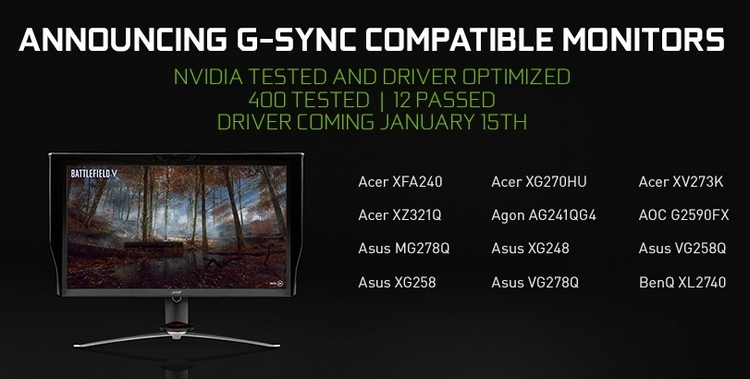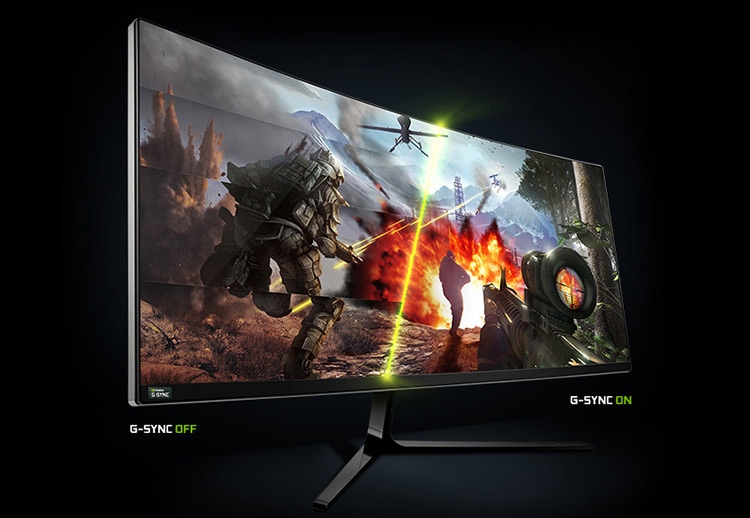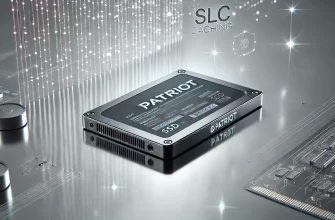A pleasant surprise from NVIDIA at CES 2019, of course, стало заявление о поддержке технологии VESA Adaptive Sync в продуктах GeForce — проще говоря, NVIDIA graphics cards now support AMD FreeSync. At the moment, only accelerators Pascal series and Turing received such compatibility, but it is a very important event: now more 550 monitors are compatible with open standard variable frame rate, and with the advent of the new driver on a GeForce last week can be tested in any of them.
NVIDIA added support FreeSync in its brand G-Sync - how to be great as it sounds, it should be emphasized, that is not so simple. Of 400 Tested NVIDIA certified only monitors 12, which provide adaptive pacing artifact-free. The company warns of possible incompatibility of other displays and artifacts, including pulsing and ghosting, while at other times they appear black frames, and so on. Reddit special branch and the associated huge table gradually create a picture, as in the case with the GeForce cards work FreeSync displays.
Eurogamer decided to test the ASUS VP28U - display 4K entry-level support FreeSync, which is not included in the dozen selected by NVIDIA. This display is aimed at budget users and at least so NVIDIA is unlikely to give him a certificate G-Sync. For the same reason curious, what you can expect?

First, the monitor via DisplayPort ASUS (yet support HDMI VRR) card GeFore RTX has been connected 2080 Ti, but then the reporter quickly switched to a less powerful GTX 1080 Ti, because the new flagship family of Turing sometimes is too fast, on it to verify the advantages of VRR. Binding to 4K / 60p in today's games, even for the GTX 1080 Ti - Ferry netryvyalnaya problem. Like many other entry-level monitors FreeSync, ASUS VP28U VRR can support only in the range between 40 and gc 60 Hz - i.e. give ms frames via 16,7-25. If the performance of the game falls out of the window, lost all the advantages of VRR. One of the many advantages of the "pure» G-Sync compensation is lower framerate, which smooths feeling at loss of VRR range. This is a very useful feature, which is only available on some screens FreeSync.
NVIDIA It recommends a dozen monitors FreeSync. What if the test GTX 1080 Ti on the base model like ASUS VP28The? Result not perfect, but he all not bad
What are the first impressions were? The technology works, and until, while the game is still in the claimed range VRR, gaming environment transformed. Now the GPU directly responsible for the new frame is displayed on the screen. Conditional vertical synchronization (V-Sync) shake during frame rate below 60 second fade. Terrible screen breaks, Related tripping V-Sync, пропадают тоже — до тех пор, while the frame rate will not fall below 40 frames / s (monitor limitations). As a result, smoothness and positive impression of the game are substantially increased even in such a low-cost display, how VP28U.
To achieve the ideal environment and stay in the claimed range VRR specific display, you must adjust the game settings. It is worth saying, FreeSync that range can vary significantly from screen to screen. So when buying a monitor without the support of G-Sync to interface with NVIDIA graphics card need to carefully study the characteristics and, possibly, look at the huge component community table - judging by her, Many displays have a strobe effect in VRR mode, which is distracting. It is from time to time appear on the ASUS VP28U, depending on the displayed content and, usually, the bottom of the VRR range. Monitor with full certification G-Sync can be more expensive, but the players do not have to worry about these issues.
Testing ASUS VP28U with console Xbox One X, which also It supports FreeSync
Adaptive synchronization used in displays with high frame rates, but ranging up to 60 Hz effect from it the strongest. It is believed, that perfect smoothness is achieved at a frequency 60 frames / s, but the synchronization observer, usually, He does not see the difference with a frequency 50 frames / s. In this optimal range is no difference between G-Sync and FreeSync.
adaptive synchronization technology is great - especially in resolutions such as 4K, where the requirements of the latest games conclude with a firm rate 60 frames / s extremely challenging (especially in the case of ray tracing, and other heavy-duty). Battlefield V produces most of the time 60 frames / s on the GTX 1080 Ti at 4K and settings Ultra. However, as an increasing number of post-processing effects during intense combat, frequency more often is in the range of 55-60 frames / s, and may fall to 50 frames / s. On a normal it throws to the screen in the eye, but VRR impression sufficiently smooth, and even some stock bandwidth allows not to spend a lot of time, adjusting the schedule of the game under the worst-case scenario.

Besides, support leading manufacturer of open standard adaptive synchronization of video cards will make monitors with support FreeSync more widespread phenomenon, if not the norm. And although such artifacts, as a gating, It is now widespread in many screens, that fact, that they paid attention, It can lead to an overall increase in the quality of support VRR. In addition to all, it allows NVIDIA to provide compatibility for HDMI televisions coming wave 2.1, VRR which is part of the specification. Separate 4K-screens from Samsung already support FreeSync, but while NVIDIA is working with VRR only through DisplayPort - hopefully, future arrives and HDMI support.

For owners of NVIDIA graphics cards it is now much easier and cheaper to use technology, which is one of the strongest improvements in the game environment on your PC. However, when choosing a cheaper option is to remember, that the quality of implementation will depend on the particular functionality of the display and may not be as reliable, like screens existing G-Sync. But thanks to the support of NVIDIA open standard VRR, finally, I received a huge boost, and it is welcome.













